Resources
Explore a range of accessible XR projects and resources below, all dedicated to making XR accessible to everyone.
Have a resource to add? Click here to let us know.
Jump to topic:
Guidelines
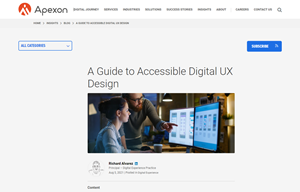
This resource guides web developers in creating personalized accessibility plans to enhance inclusive design for diverse users and improve website effectiveness.
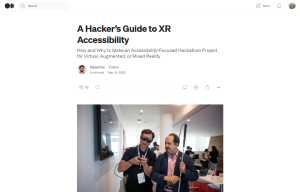
Explore XR accessibility in hackathons with XR Access Coordination & Engagement Team Lead, Dylan Fox, for insights on creating an accessibility-focused XR hackathon project.
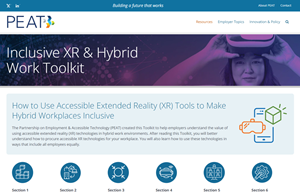
Created by the Partnership on Employment & Accessible Technology (PEAT), this toolkit helps employers understand the value of accessible XR technologies for hybrid work environments, promoting inclusive practices.
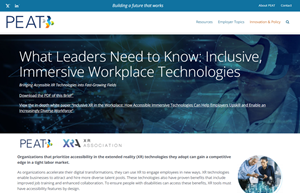
A leadership case for integrating accessible XR into workplaces, presented by the Partnership on Employment and Accessible Technology (PEAT).
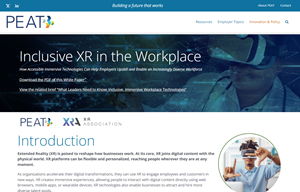
This whitepaper from PEAT assists organizations in upskilling and enabling a diverse workforce, ensuring the adoption of immersive technologies that are accessible for all.
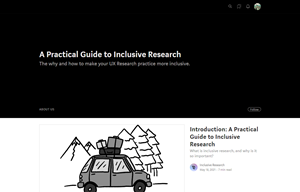
Practical guidelines from experience researchers, assembled by Medium, to help organizations adopt inclusive research practices applicable across various technology domains, including XR.
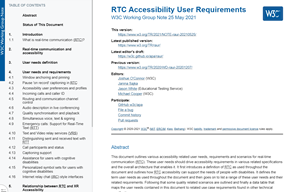
The W3C document outlines accessibility needs, requirements, and scenarios for real-time communication, influencing related specifications and overall architecture.
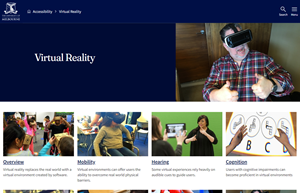
The University of Melbourne’s Accessibility of Virtual Environments resource page provides in-depth guides for XR accessibility as it relates to cognition, vision, mobility, and more.
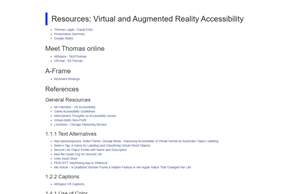
Compiled by Thomas Logan of Equal Entry, this list of resources helps developers apply existing accessibility guidelines to AR and VR development.
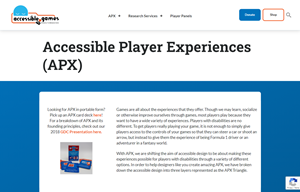
Games’s APX site introduces innovative ideas for game accessibility, providing design patterns and examples for designers and developers.
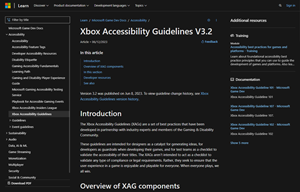
Microsoft’s guidelines offer best practices to assist designers and developers in generating ideas, establishing ‘guardrails,’ and validating the accessibility of their games.
Organizations
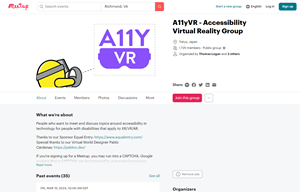
A11yVR hosts regular meetups and discussions focusing on making VR accessible.
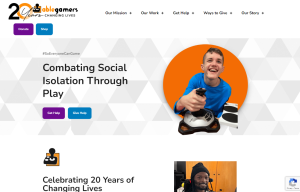
AbleGamers provides custom video game equipment for people with disabilities, promoting inclusion and an improved quality of life.
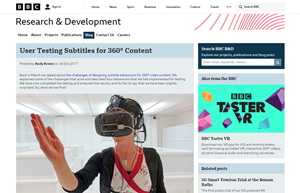
The BBC’s Research & Development group has tested subtitles for 360-degree video content, with whitepapers on subtitle user experience and subtitle behavior available.
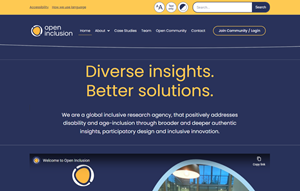
OpenInclusion’s accessibility consultancy services help businesses understand and build for people with disabilities.
Tools & Projects
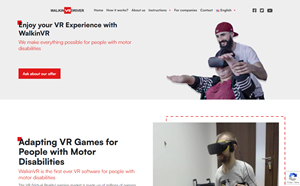
WalkInVR is a driver designed to adapt VR environments, making SteamVR platform games and software accessible to individuals with physical disabilities. Tested with Oculus Rift, Oculus Rift S, HTC Vive, and Valve Index.
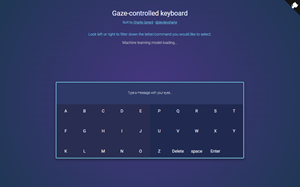
Developed by Charlie Gerard, this Javascript library utilizes machine learning to detect eye movements, enabling the creation of gaze-controlled experiences.
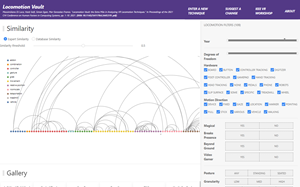
Locomotion Vault offers a collection of VR locomotion techniques for diverse development needs, with accessibility as a filter option. Developed in collaboration with Microsoft, it was published in ACM CHI 2021.
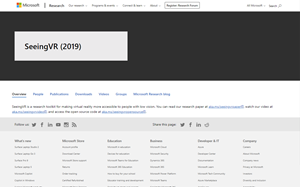
The SeeingVR tool enhances VR applications for individuals with low vision through visual and audio augmentations, using plugins and developer input.
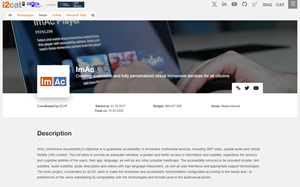
The EU-funded ImAc project explores the integration of accessibility services with immersive media. Subtitling projects demonstrate how text can enhance 360° video experiences.
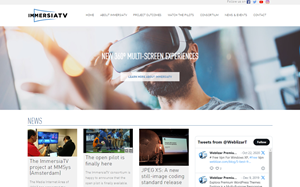
ImmersiaTV provides an integrated toolset for producing and distributing immersive and interactive content across various devices and formats.
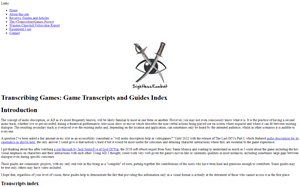
The #TranscribingGames project aims to provide audio descriptions for mainstream video games, enhancing accessibility for individuals with low vision.
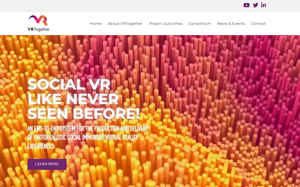
An EU-funded project, VR Together aims to improve the capture and rendering of audio, video, and graphics in real-world environments, enhancing the realism and social aspects of virtual experiences.
Articles
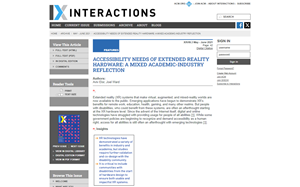
XR Access leaders Aviv Elor and Joel Ward reflect on a yearlong collaboration between academic and industry organizations, evaluating the current and future state of XR hardware accessibility. They provide insights and future directions for accessible XR hardware research.
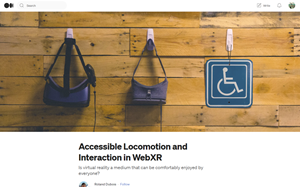
Product designer Roland Dubois explores the development of an accessible XR prototype, focusing on locomotion and interaction in the WebXR context.
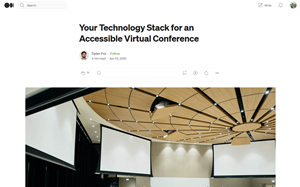
UX designer Dylan Fox outlines tech stack components for virtual conferences, offering guidance on making these events more accessible.
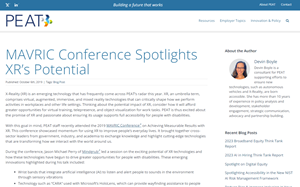
PEAT explores XR’s potential impact on virtual training, telepresence, and object visualization for work tasks. The article emphasizes PEAT’s commitment to ensuring XR usage supports full accessibility for people with disabilities.
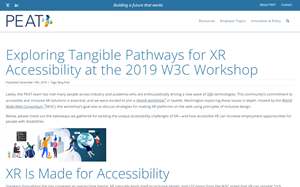
The PEAT team discusses their engagement with industry and academia in driving XR technologies. This article highlights their commitment to accessible and inclusive XR solutions, focusing on a W3C workshop exploring strategies for making XR platforms on the web using inclusive design principles.
Reports
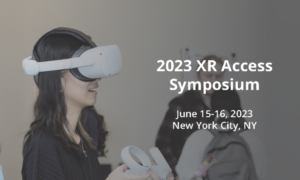
Compiled from our notes and presentations, this report summarizes the fifth annual XR Access 2023 Symposium. Our theme this year was “Seizing Advancements for Access,” which resonated our vision to harness the momentum of rapid advancements in XR hardware and software, as well as breakthrough technologies like AI, for the benefit of disabled individuals.
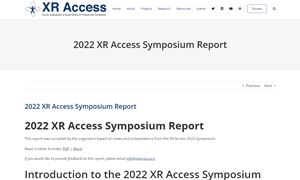
Compiled by organizers, this report summarizes the XR Access 2022 Symposium based on notes and presentations.
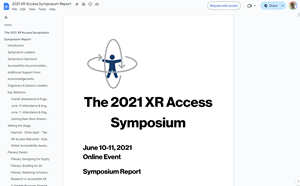
Read the report from the 3rd XR Access Symposium, held June 10-11, 2021. The report includes summaries of each plenary panel and breakout group.
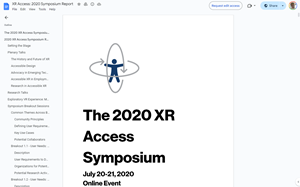
Report for the 2nd Annual (2020) XR Access Symposium, a virtual conference convened on July 20 and 21, 2020. The event was designed to be accessible from the start, with closed captioning, sign language interpreters, sighted guides, and significant involvement at all levels by people with disabilities.
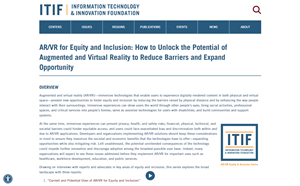
This series of three reports from IT Industry Foundation (ITIF) focuses on “AR/VR for Equity and Inclusion: How to Unlock the Potential of Augmented and Virtual Reality to Reduce Barriers and Expand Opportunity”. It provides insights for policymakers and federal agencies to establish policies and best practices for equity and inclusion in AR/VR.
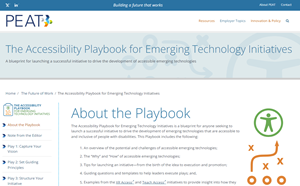
A blueprint for launching initiatives to drive the development of accessible emerging technologies. The Playbook includes examples from XR Access and Teach Access initiatives to provide insight into how they approached executing each play.
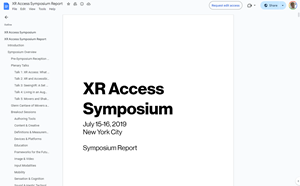
Summarizing the first-ever XR Access Symposium in 2019, hosted by Cornell Tech and Verizon Media, this report emphasizes the importance of designing XR technologies with accessibility in mind to ensure inclusion for people with disabilities.
Multimedia
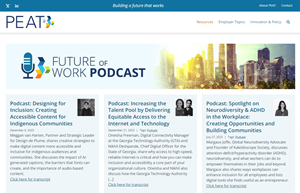
Hosted by the Partnership on Employment and Accessible Technology (PEAT) and leading HR blog Workology.com, the Future of Work Podcast explores the impact of emerging technology trends in the workplace on people with disabilities.
Episodes of interest to the XR Access community include:
- Making Workplace Digital Communication Accessible, featuring Justin Herman of Twilio
- The Value of VR for Training and Employee Development, featuring George Karalis of STRIVR
- Creating VR Workplace Training Programs for People with Disabilities, featuring accessibility specialists Chris Baumgart and Meagan Little
- How XR is Changing Workplace Training and Accessibility, featuring Joel Ward of Booz Allen Hamilton
- Virtual Reality and Accessible Workplace Technology, featuring Beth Crutchfield and Jessie Haugh of Level Access
Presentations
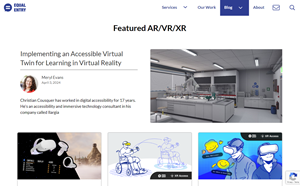
Equal Entry’s virtual reality content focuses on accessibility, with team members co-hosting A11yVR meetup.
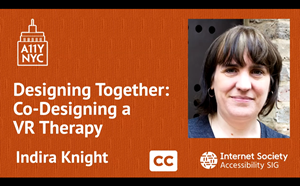
Indira Knight from the Royal College of Art describes “gameChange,” a VR therapy co-designed with individuals with psychosis to boost confidence in everyday situations.
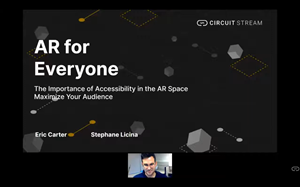
A workshop by Eric Carter and Stephane Licina on Circuit Stream covering various UX/UI examples of accessible design interaction approaches.

Martez Mott from Microsoft Research explores how VR offers new ways for users to interact with digital content, emphasizing the importance of incorporating accessibility in VR design.
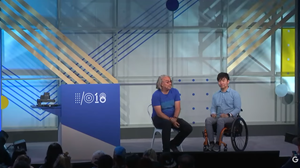
A talk from Google I/O 2018 by Christopher Patnoe and Ran Tao covering ways to make VR and AR more accessible to a broader audience.
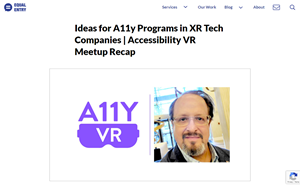
Bill Curtis-Davidson, XR Access community leader, outlines how XR technology companies can implement accessibility programs for their products, content, and experiences.
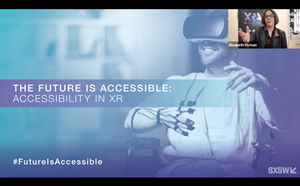
A talk by XR Access community leaders at South By Southwest (SXSW) 2020 emphasizing the importance of accessibility in XR technology for reaching its full potential.
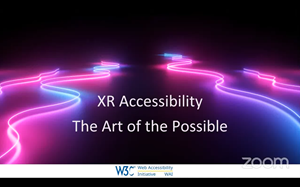
A talk by accessibility specialist Joshue O Connor as part of Inclusive Design 24 in September 2020, exploring the implications of XR technology for people with disabilities.
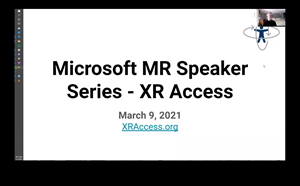
Panelists Larry Goldberg, Christine Hemphill, Regine Gilbert, and Dylan Fox define accessibility in the context of XR and introduce the XR Access Initiative, focused on making augmented, virtual, and mixed reality accessible.
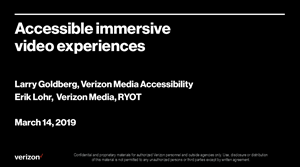
Larry Goldberg (Verizon Media), and Erik Lohr (RYOT Studios) present Verizon’s vision for the future of accessibility in extended reality and immersive video.